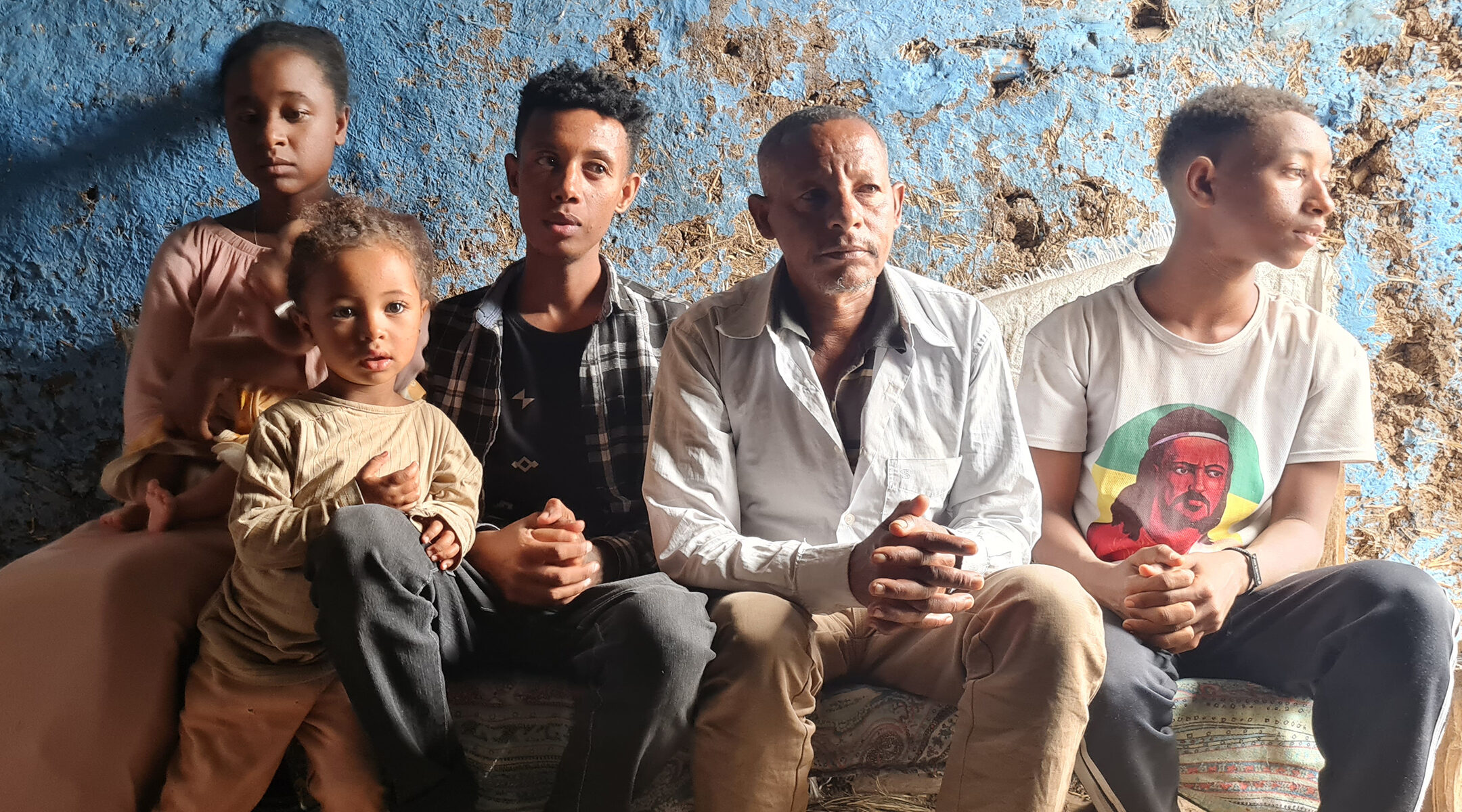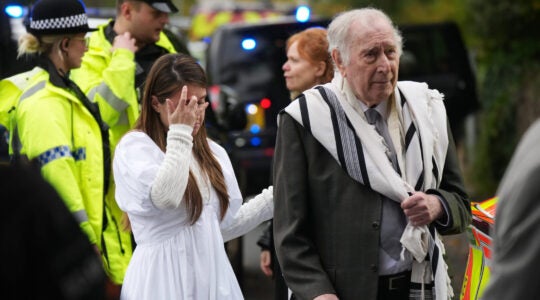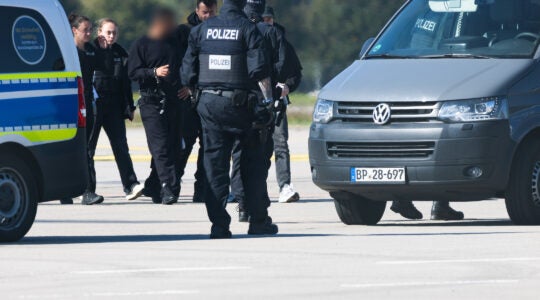GONDAR, Ethiopia (JTA) — It was love at first sight for Wesom Mellesse when his wife stepped into his metal shop 17 years ago.
“Her dad took her into my shop because he needed me to fix their plow and when I saw her, we understood that we felt something. We fell in love. I asked her father if we could marry,” said Mellese, a 38-year-old father of three who now works as a carpenter in Gondar, a northern city that is Ethiopia’s sixth largest.
His choice in marriage was even more fateful than he realized at the time.
Because of it, Mellese became ineligible to join his father, sister and brother when they emigrated to Israel in 2007 along with other Falash Mura — Ethiopians whose Jewish ancestors converted to Christianity.
Mellese’s story is typical of cases that have turned the Falash Mura immigration into a painful and protracted saga despite multiple Israeli governments’ pledges since 1992 to resolve it.
Nearly a dozen times, Israeli governments have committed to admitting batches of Falash Mura, under pressure to allow them to reunite with family members in Israel. And just as often, delays and stringent rules have fueled additional family separations, creating a self-perpetuating cycle.
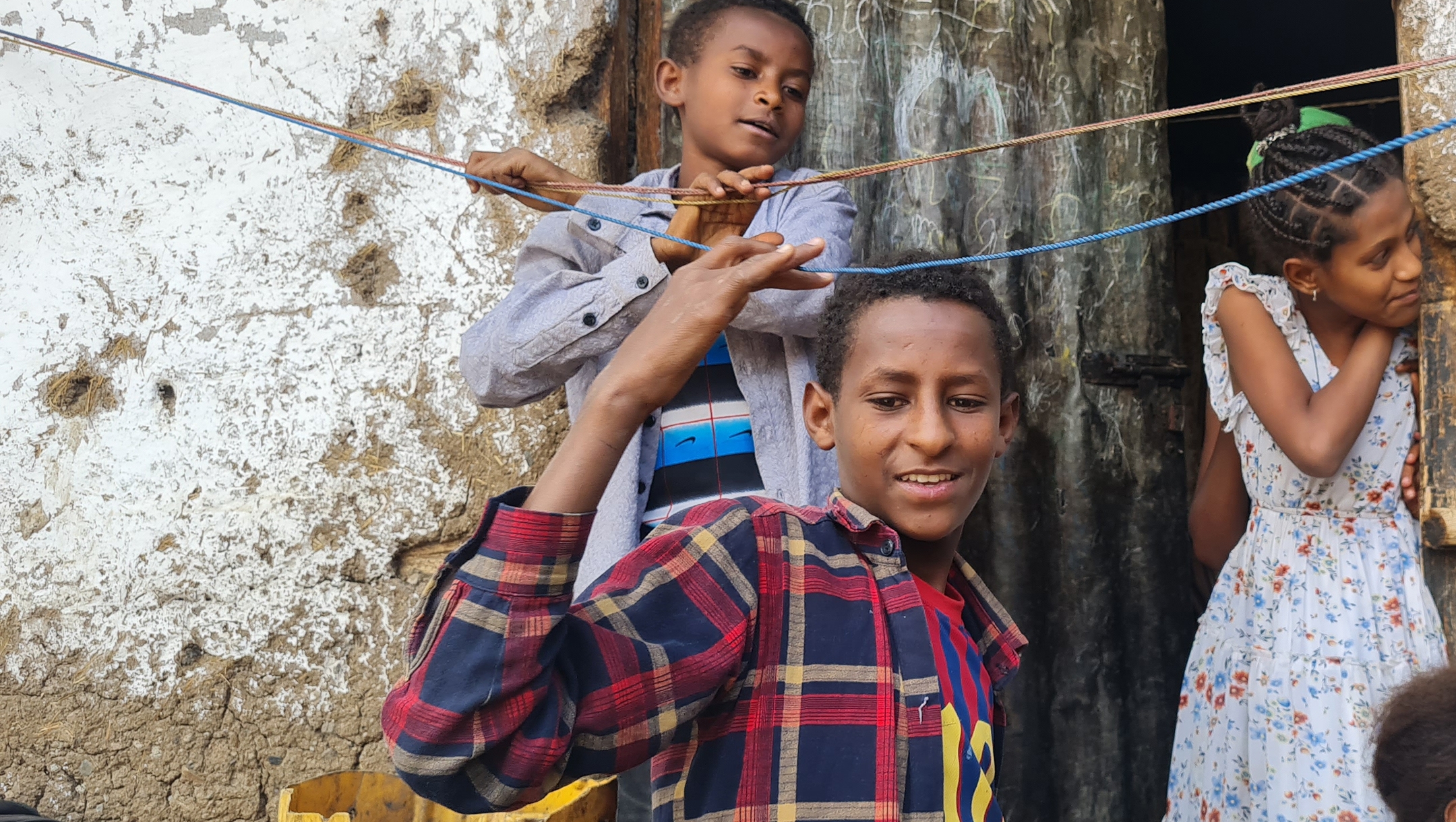
Children of Falash Mura children help hand the washing outside their home in Gondar, Ethiopia, May 29, 2022. (Cnaan Liphshiz)
From the start, Israel committed to admitting only Falash Mura whose parents or children live in Israel. Their spouses and children can come along — but only if the children have not married or had children. The rules are meant to prevent large numbers of non-Jews or people not considered Jewish by Israel’s Orthodox Chief Rabbinate to immigrate to Israel.
Some Falash Mura have put marriage on hold for years to remain eligible for immigration to Israel. Others, such as Mellese, have gone forward with their own lives, only to be shut out of a dream they had long nurtured.
“It’s a sad story,” Mellese, a gangly man with a deep voice, told the Jewish Telegraphic Agency last month at a cafe overlooking Gondar’s many hills and muddy-banked lake. The local Falash Mura community was preparing to send off more than 300 members who had successfully met Israel’s immigration requirements for them.
The separation of Falash Mura families, which is connected to Israel’s desire to limit immigration by non-Jews, has perpetuated the issue, which increasingly is dividing Israeli society and especially the country’s minority of about 160,000 Israelis with Ethiopian roots.
To understand how, “one must return only about 2,600 years in time,” according to Micha Feldmann, the first envoy to Ethiopia by the Jewish Agency for Israel, a semi-governmental body that handles immigration to the Jewish state by Jews and their relatives, or aliyah.
That is when Ethiopian Jews believe their unique community was established, pursuing its own isolated trajectory.
Changes were slow and far between for that community, known as Beta Israel. That is, until the 1800s, when several hundreds of Beta Israel families, primarily in the country’s north, were forcibly converted to Christianity as it took hold as the country’s predominant faith.
The converts, known as Falash Mura, kept some Jewish customs. But they also married non-Jews and many had abandoned the custom of circumcision. In effect, they had largely split off from Beta Israel, where intermarriage was shunned and traditions strictly observed.
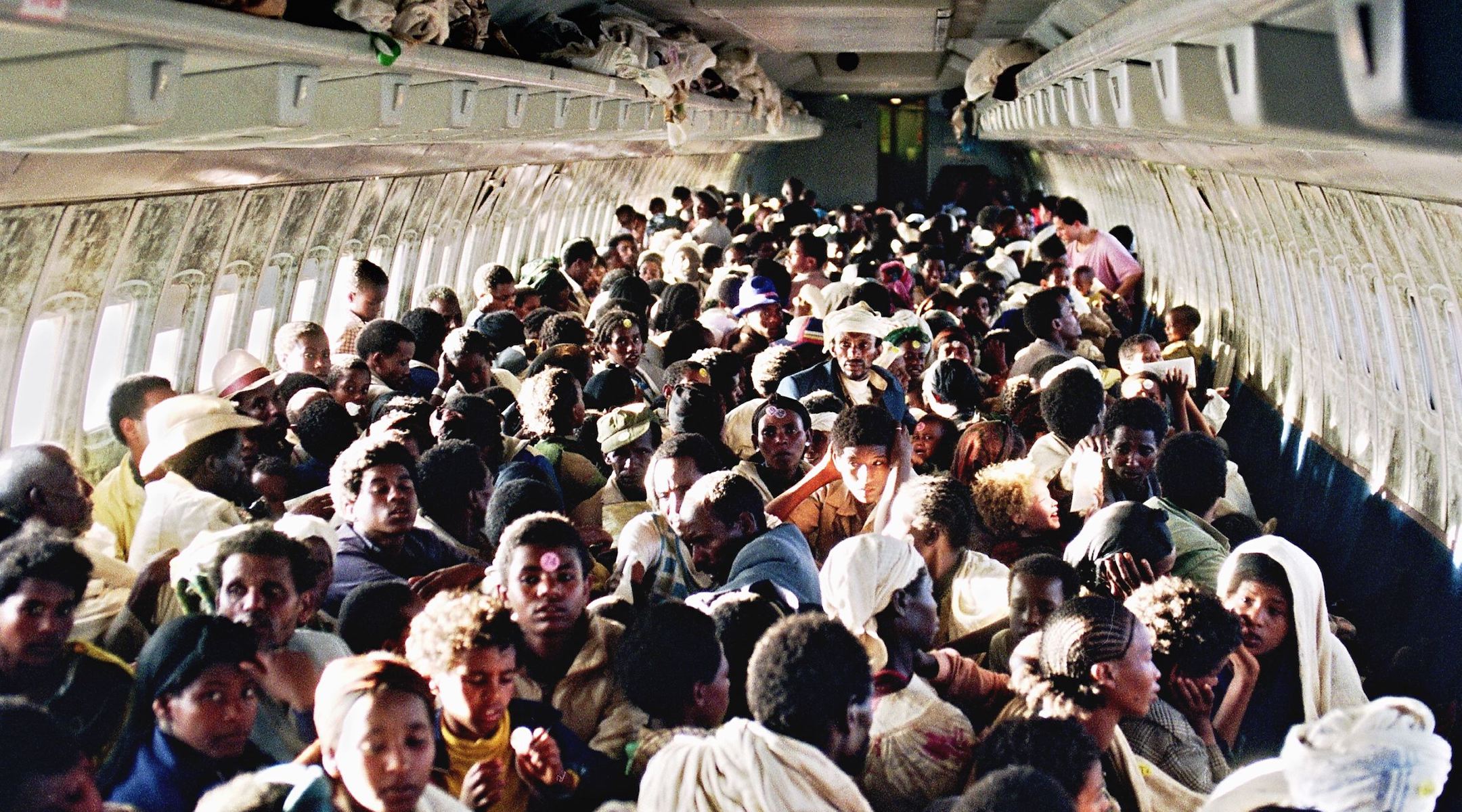
Ethiopian Jews on a flight to Israel in 1991. (Patrick Baz/AFP via Getty Images)
In 1991, almost all Ethiopia’s 14,000-odd remaining Beta Israel Jews were airlifted to Israel.
But Jewish presence remained.
In Gondar, where most Falash Mura live, members of that minority came together to preserve their heritage, including at what is now known as the Hatikvah Synagogue.
Built with money from Jewish-American donors and the Jewish Agency, it’s a large corrugated-metal shed with an elevated watchtower on its southern end. The lyrics of “Hatikvah,” Israel’s national anthem, which gave the synagogue its name, are hand-written on the northern wall, the one facing Jerusalem, and the Torah ark.
Many of the community members know the song by heart. Many members of the community say they eat only kosher food. Local members slaughter chickens for meat in accordance with the principles of halacha, or Jewish law, two community members told JTA.
Dozens and sometimes hundreds of Falash Mura gather here for morning prayers, which take place according to rituals present in traditional synagogues the world over. The men and women sit in separate sections, with a hanging curtain that is dropped down during some prayers. The women ululate softly when the Torah is carried in front of them. The men kiss the Torah with their prayer shawls. Those who don’t, lift their right-hand pinkies and point them at the scroll.
Back in Israel, Beta Israel Jews with Falash Mura relatives in Ethiopia mounted in 1992 the first campaign to let their relatives in. Activists for this cause unfurled a banner reading: “I want my mother, I want my father” at a rally where politicians responsible for the 1991 airlift, known as Operation Solomon, expected to bask in the community’s gratitude, Feldmann, the Jewish Agency envoy, recalled.
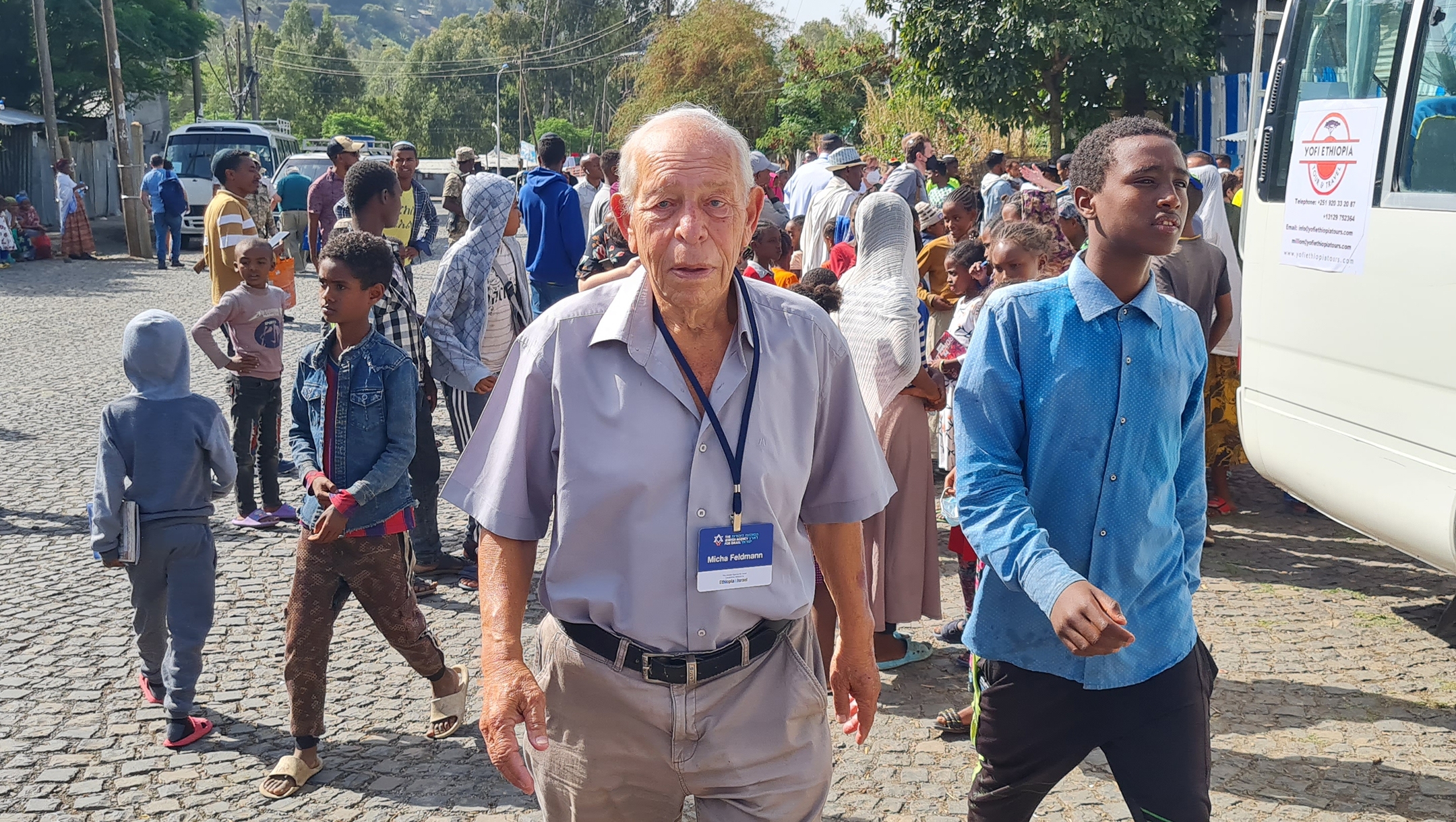
Micha Feldmann, the Jewish Agency for Israel’s first representative in Ethiopia, walks outside the Hatikvah Synagogue in Gondar, Ethiopia, May 31, 2022. (Cnaan Liphshiz)
This protest led to a decision by then-Prime Minister Yitzhak Rabin to allow in about 2,000 Falash Mura. This effort was the first major exception to Israel’s Law of Return for Jews and their relatives, under which Beta Israel Jews came. Falash Mura do not qualify under the law. They arrive under a government decree on the condition they undergo an Orthodox conversion to Judaism.
The Falash Mura who came in 1992 had left behind first-degree relatives who they demanded be let into Israel. Separately, more Beta Israel immigrants came forward and asked that their Falash Mura relatives also be allowed to immigrate.
This set the stage for successions of rallies over the past 30 years, some of them violent, demanding reunification for Falash Mura.
The rallies and other efforts proved effective: Since 1992, the Israeli government has passed at least 11 resolutions permitting entry by Falash mura. Often delayed in their application, each new resolution announced a round of immigration by a few thousand Falash Mura, but with stipulations that ended up separating families — thus fueling the next wave of protests.
So far, at least 25,000 Falash Mura (some Ethiopian Jews believe the actual number is higher) have trickled into Israel, out of 95,000 who have immigrated from Ethiopia in total. The number of Falash Mura who meet the government’s current requirements is estimated at 10,000, but the figure is fluid. In 2007, the government brought in 7,000 Falash Mura whom it called the last.
In 2020, the government and the Jewish Agency launched another wave of 3,000 newcomers under an operation codenamed Zur Israel. Delayed by COVID-19 and clashes with rebels in Ethiopia, the operation has brought so far about 500 Falash Mura to Israel, most recently in two flights last month with 300 immigrants.
A ceremony at Hatikvah synagogue to send them off was attended by 1,000 people dressed mostly in white and ended with the singing of “Hatikvah,” Israel’s national anthem. The service was led by local young men who have been studying Judaism online with Menachem Waldman, the Israeli government’s person in charge of issues related to converting Ethiopians.
Some of the new immigrants, including Kefale Tayachew Damtie, a father of six who flew to Israel with his entire nuclear family to be reunited with his mother, have been waiting for more than 20 years. He had forbidden his eldest three children, aged 16 to 23, to marry in Ethiopia — where the average age for marriage is 16 — so that they remained eligible to immigrate.
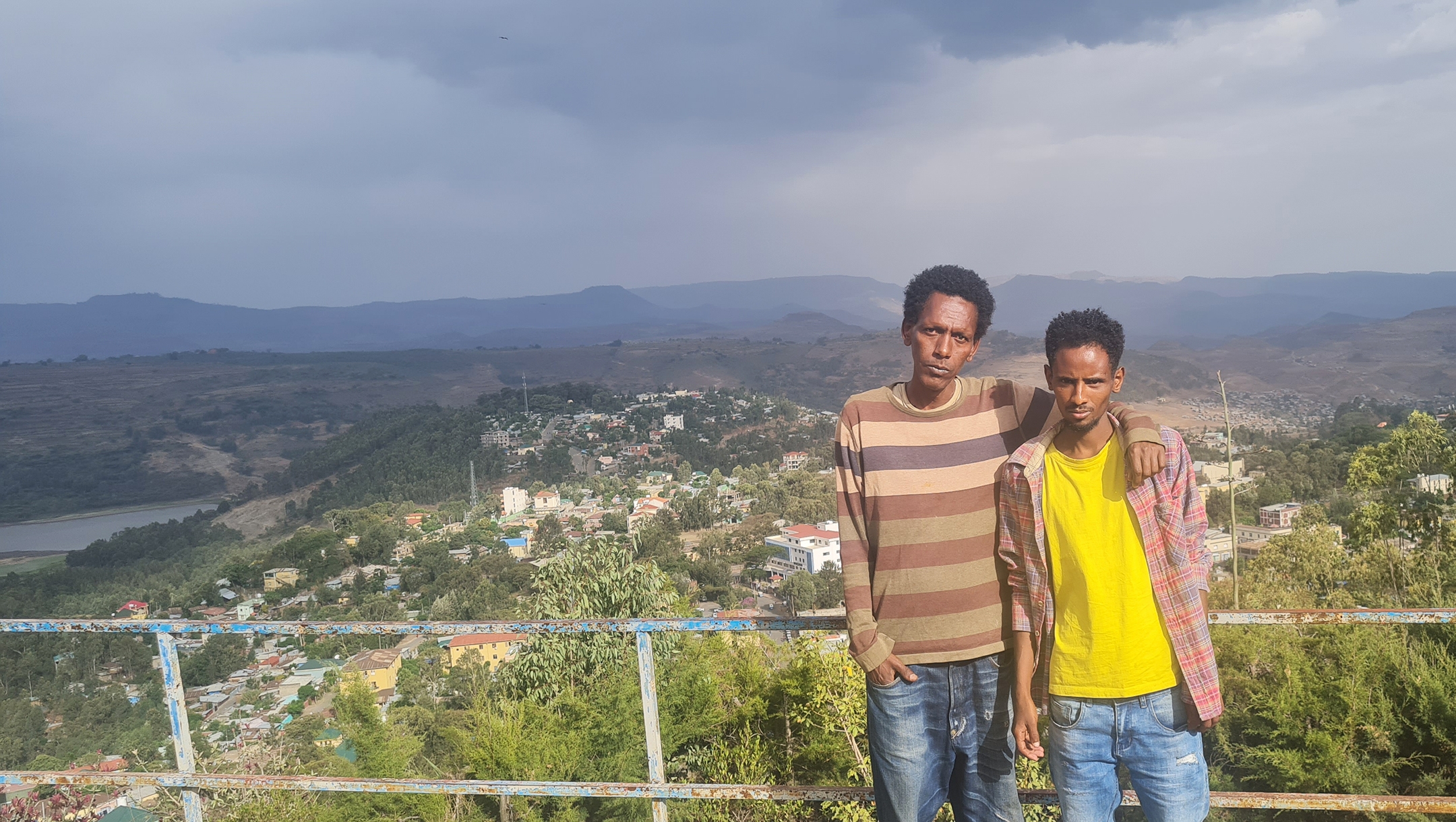
Wesom Melesse, left, and Yesuf Getahun, two Falash Mura seeking to immigrate to Israel, pose against the background of Gondar, Ethiopia, May 30, 2022. (Cnaan Liphshiz)
Others went further to ensure continued eliigibility. Chalachew Teshager Gerem, a 35-year-old computer science lecturer at Gondar University, chose to remain unmarried even without a parental veto on marriage, he told JTA.
Some have lied during their immigration process, according to Shay Felber, the head of the Jewish Agency’s aliyah department.They omitted wives and children whom they left behind in the hope of getting them on a plane to Israel under some future government resolution. In the meantime, they send money to feed their families in Ethiopia, where the average monthly wage is $172.
The Falash Mura put their lives on hold in additional ways in connection with the awaited plane ticket to Israel. Teshager Gerem’s father, Teshager Gerem Bogal, moved his family from their village to Gondar nine years ago to prepare for the move to Israel.
In their native village, the family of nine had a good income and spacious accommodations. Gondar was a serious downgrade: Before they left for Israel, the family shared a single dirt-floor room with no running water.
Now, all of the immigrants will live for two years at a government absorption center in Be’er Sheva where they will be taught Hebrew and undergo conversion.
Both that family and that of Kefale Tayachew Damtie say they are treated differently in Ethiopian society because they are considered Jewish. (Damtie is sure his landlord had hiked the rent for that reason, he said.)
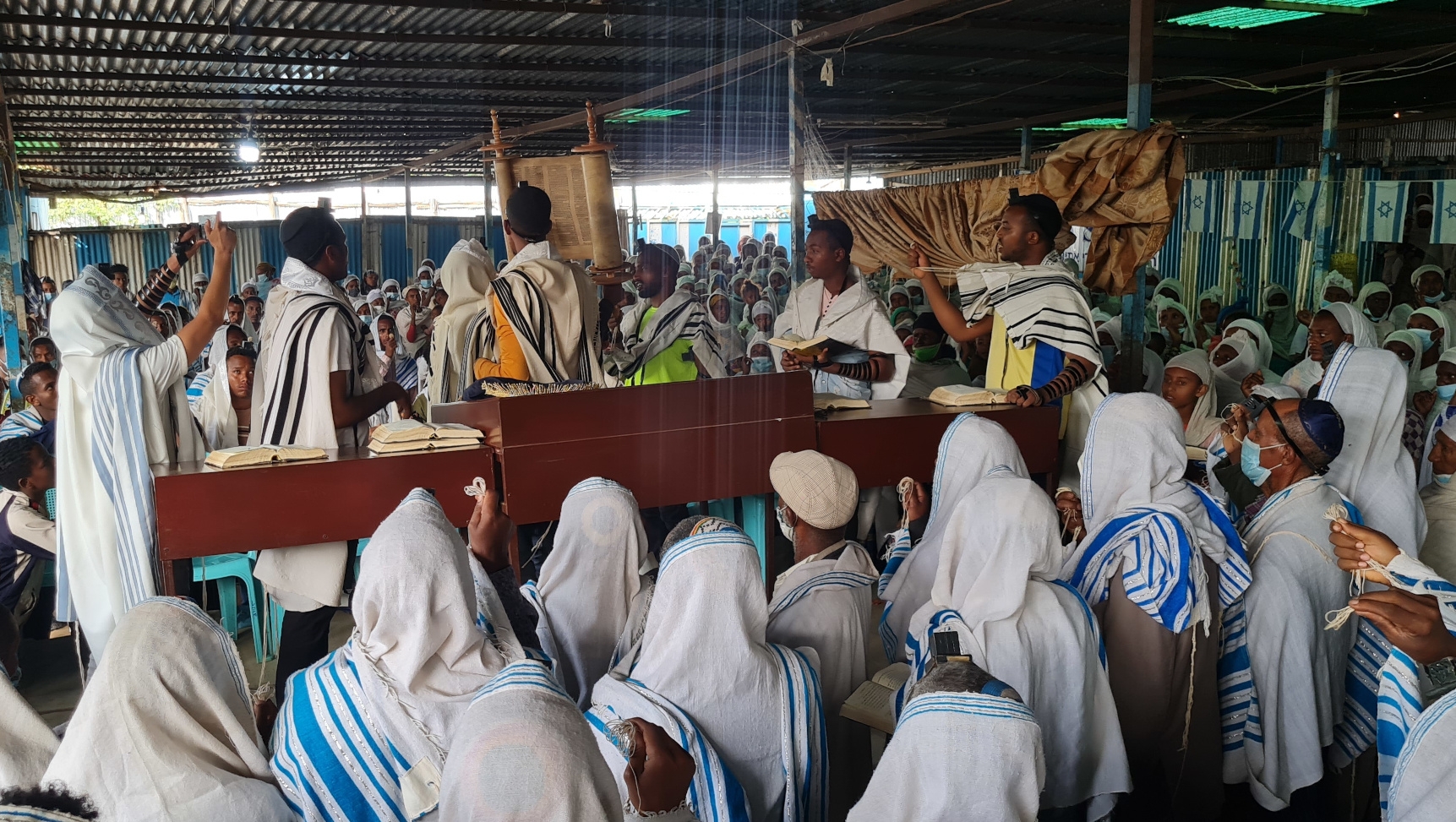
Members of the Falash Mura community celebrate with a festive prayer service the immigration to Israel of 180 people from Gondar, Ethiopia, May 31, 2022. (Cnaan Liphshiz)
With the money from selling their farm, the Gerem family was able to afford to send all their children, aged 17 to 35, to high school and university to prepare them to better integrate into Israel’s modern society, the father of the family said at his home during a visit that the Jewish Agency’s staff of 20 in Ethiopia organized for journalists.
The integration of all Ethiopians has been slow, painful but ultimately successful, Feldmann said.
“I was naive. I thought it would take a generation. Now I think it will take several,” said Feldmann, who first came to Ethiopia almost 40 years ago. “But it’s happening.”
As the ranks of the Falash Mura grew, Beta Israel and other Jews began charging that people applying for immigration from Ethiopia have no Jewish heritage. Some of the newcomers were “not Falash Mura at all. They are complete and utter Christians, who are changing the character of our community, and are here just to get out of Africa,” one critic, Avraham Yerdai, a former vice chair of the Union of Ethiopian Jews, the community’s main umbrella group, told JTA.
The group’s current leadership supports immigration by Falash Mura. But Yerdai and other critics of the current wave of immigrants are worried that others are taking advantage of the open door.
“The promoters of immigration achieve their goals through allegations of racism. And that’s effective these days. So non-Jews are coming now to Israel because they’re Black,” said Ayanawo Ferada Senebato, an Ethiopian-born journalist and writer. Last year he helped Yerdai petition the Israeli Supreme Court to stop the Falash Mura immigration. The court dismissed the petition, citing jurisdiction issues.
Some promoters of Falash Mura immigration say that they see racism by white Israelis as a major reason for the limitations of immigration from Ethiopia.
“This is pure racism,” Avraham Negosa, a Likud lawmaker who was born in Ethiopia, said in a 2016 speech about the government’s attitude. “There’s money to bring Jews from America and Europe. But not for Ethiopians.”
Even before the Black Lives Matter movement moment of 2020, the racism allegations regarding the treatment of the Falash Mura touched a raw nerve in Israeli society, which has seen several scandals involving the treatment of Ethiopian Jews.
The exclusion of Ethiopian students from state-funded haredi and other schools has been a recurrent phenomenon. Another has been medical authorities’ refusal to use blood donations from Ethiopians until this practice was banned in 2017, following several street protests.
The 2019 slaying of Salomon Teka, an 18-year-old Ethiopia-born man, by a police officer resulted in the most violent wave of protests by Ethiopians so far. To many he is a symbol of over policing in neighborhoods with many immigrants from Ethiopia. The officer, who claims he felt Teka behaved violently, is standing trial for manslaughter.
Senebato acknowledges that there are expressions of racism against Israelis of Ethiopian origin. But, he said, “the racism issue is unrelated to the Falash Mura one, which is controversial especially among Israelis of Ethiopian descent.”
Israeli politicians from that community, including Absorption Minister Pnina Tamano-Shata, “are benefiting from the arrival of people who are grateful and may vote for them,” Senebato said. (During a visit to Addis Ababa last month to oversee the the immigration flights, Tamano-Shata said she regards all the people waiting to immigrate in Ethiopia as “our brethren and I have made it my mission to make sure none are left behind.”)
Some Falash Mura cite financial reasons as their main incentive for immigrating.
Wosem, the Falash Mura 38-year-old who cannot immigrate to Israel because he got married, pointed to the reality of life in Ethiopia, where public healthcare is nonexistent and the average life expectancy is 67.
“To be honest … full of suffering. TIA,” he said, using an acronym for “this is Africa” that locals say, often to express exasperation. “I mean, everybody needs a better life, you know. I need to change my life with my kids. Five months ago there was war. They burned my house. I had stayed with Falasha friends. Moved here to the city with my three children. No job opportunities. I don’t care about me but want a better life for my children.”
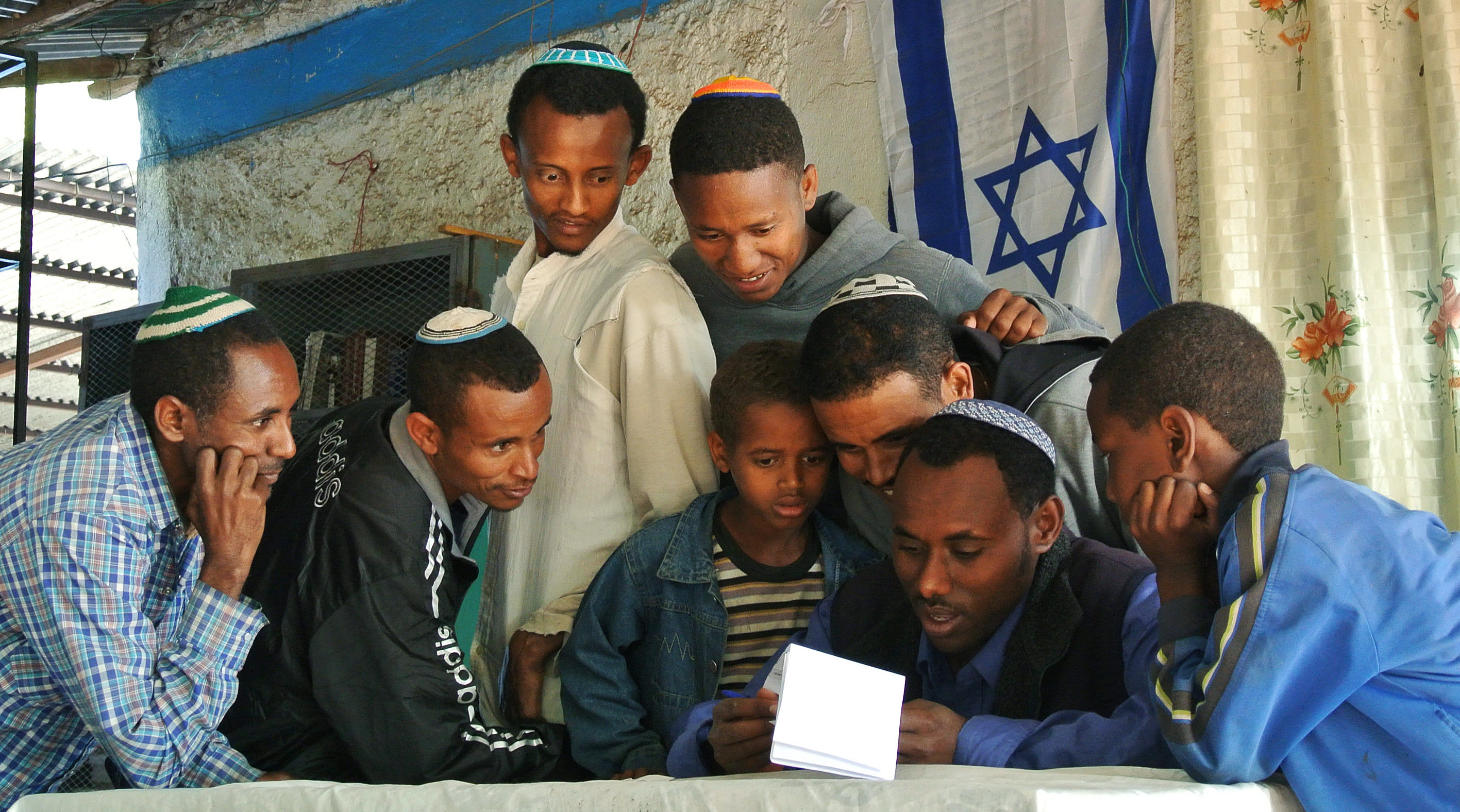
Ethiopian Jews gather at a makeshift synagogue in Gondar to see if they have been given a date to move to Israel. (Jenny Vaughan/AFP via Getty Images)
Aliyah officials realize that the Falash Mura immigration is in a self-perpetuating cycle.
“It is endless,” Yaakov Hagoel, the acting chairman of the Jewish Agency, told JTA about the way that Falash Mura immigration has been handled so far. Israel should “call for applications, set a time limit, allow applicants to come forward, approve [the eligible], fly them in and when the time limit expires end the subject and refuse to reopen it,” he said.
Tamano-Shata has other ideas, but she also seeks to “end this painful saga and bring a solution,” she told several dozen representatives of the Jewish Federations of North America and other delegates of Jewish-American groups, as well as International Fellowship of Christians and Jews staff, who came to Ethiopia on the Jewish Agency mission.
Her plan is to issue one final call for applications for immigration by Falash Mura and to involve the kesim, the spiritual leaders of the Ethiopian-Israeli Jewish community, in vetting the applicants, she said.
“Then we declare — not Sofa Landver declares, Pnina Tamano declares! – that the Falash Mura aliyah is over, we are returning to aliyah only according to the Law of Return,” she said. (Sofa Landver, an Ashkenazi Jew who was born in Russia, is one of Tamano-Shata’s predecessors as absorption minister.)
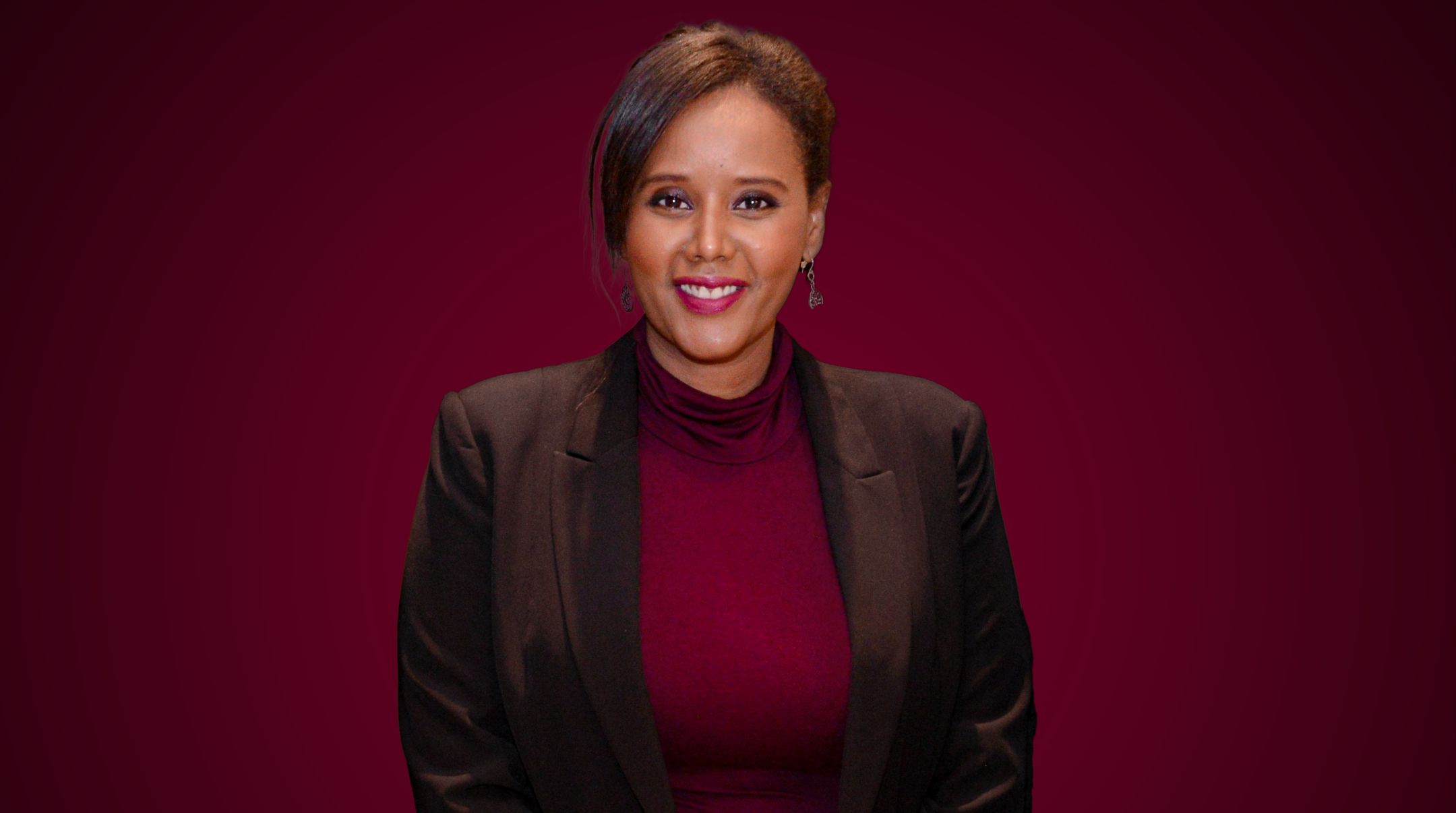
Israeli absorption minister Pnina Tamano-Shata poses in an undated photo. (Natan Weil/Government Press Office)
As the plane with the Falash Mura immigrants took off from Addis Ababa to Israel, Ainadis Kendi, a mother of two in her twenties, and her 3-year-old, Yarid, took in the view of the slopes of the mountains around the capital city of their native country. The 180 newcomers began clapping with excitement as the plane took off, and then again as it prepared to land.
A graduate of Addis Ababa University’s mathematics department, she speaks basic English and is working on her Hebrew, she said. Ahead of the flight, she modified a white dress by embroidering large, blue Stars of David on its hem and sleeves. “This is a festive day,” she explained.
But over the course of the flight, she grew more nervous.
Asked by a journalist about her feelings at that moment, she was visibly embarrassed. Discussing emotions is uncustomary in her culture. “I don’t know,” she replied. “Because I don’t really know the place where we’re going.”
JTA has documented Jewish history in real-time for over a century. Keep our journalism strong by joining us in supporting independent, award-winning reporting.
